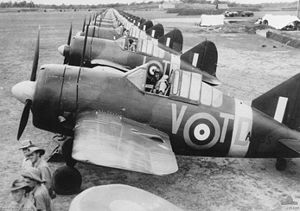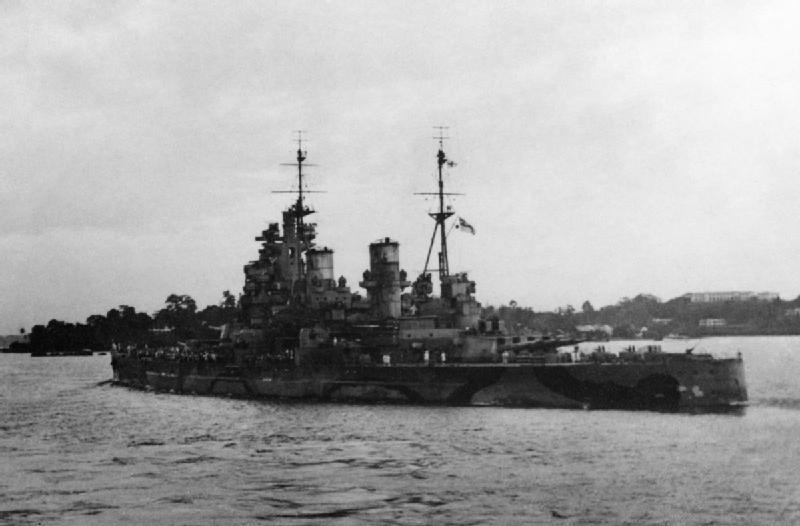| Java Sea:
Defending Singapore
By Patrick Collins
April 2022
 When Japan launched a new wave of aggression in December, 1941, her target was not really Hawaii, or even the Philippines. The only real motive Japan had for attacking was to obtain the oil in the Dutch East Indies, and the tin, rubber, and more oil in Malaya and Burma. Having access to these resources (and denying them to her enemies) was in fact the main objective driving Japanese planning. To counter American forces, the main striking force of the Nihon Kaigun would attack Pearl Harbor, and, the IJN planners hoped, the U.S. fleet, knocking it out at the beginning of the war. As we saw in an earlier Daily Content, a properly prepared Pearl Harbor was no walkover. In reality, the plan to attack Pearl left the other assaults on Malaya and the Philippines with very little naval support. When Japan launched a new wave of aggression in December, 1941, her target was not really Hawaii, or even the Philippines. The only real motive Japan had for attacking was to obtain the oil in the Dutch East Indies, and the tin, rubber, and more oil in Malaya and Burma. Having access to these resources (and denying them to her enemies) was in fact the main objective driving Japanese planning. To counter American forces, the main striking force of the Nihon Kaigun would attack Pearl Harbor, and, the IJN planners hoped, the U.S. fleet, knocking it out at the beginning of the war. As we saw in an earlier Daily Content, a properly prepared Pearl Harbor was no walkover. In reality, the plan to attack Pearl left the other assaults on Malaya and the Philippines with very little naval support.
But in the Japanese concept of airpower, that was not a serious issue. Their concept of having land-based aircraft control long distances of ocean meant that the forces sailing from Taiwan and Hainan to the Malaya-Thai border and the Philippines would be covered from bases in Taiwan and French Indo-china. This also meant that it was imperative to ensure there was no effective air power to contest these invasions.
 In the Philippines, the efficient Japanese intelligence operation quickly found out that the islands were being reinforced with modern P-40s, to replace the very badly outdated P-26s and P-35s that the Air Corps had there. It is much less clear if the Imperial planners decided that the quantities of reinforcements were too few, or if they somehow knew of the very real constraints on training, ammunition, and readiness meant that the Philippines were less of a threat, but it IS known that just before the attack on Dec. 8th (local time) significant airpower was taken from the assault on the US islands, and shifted to the attack on British Malaya and Singapore. In the Philippines, the efficient Japanese intelligence operation quickly found out that the islands were being reinforced with modern P-40s, to replace the very badly outdated P-26s and P-35s that the Air Corps had there. It is much less clear if the Imperial planners decided that the quantities of reinforcements were too few, or if they somehow knew of the very real constraints on training, ammunition, and readiness meant that the Philippines were less of a threat, but it IS known that just before the attack on Dec. 8th (local time) significant airpower was taken from the assault on the US islands, and shifted to the attack on British Malaya and Singapore.
Singapore was a rather new base for the Royal Navy. For most of the 19th century, the Royal Navy did not really worry about naval supremacy. But the rise of ironclads, and then steel ships, brought a change. At first, the British managed it by expanding their navy, relying on British industrial might. Later, they made astute alliances, essentially “outsourcing” Pacific sea control to the Japanese, while gaining contracts for Japanese ships. This policy paid very handsome dividends in World War I, as the Japanese efficiently scooped up German colonies in China and the Pacific. It did not pay off quite as much as the Admiralty would have liked, as they asked for the Kongo-class battle cruisers, or at least some of them, to join the Grand Fleet. The Japanese did send some destroyers to the Mediterranean, but not the pride of their fleet.
In his monumental history of World War II, Winston Churchill blames U.S. pressure for Britain abandoning the treaty with the Japanese. In fact, the alliance was under a lot of pressure from World War I. The Japanese unwillingness to send even one Kongo rankled, and the Japanese demands on China (the “Twenty One Demands”) struck at a vital British interest, their commerce in China. It is also very hard to imagine the British-Japanese alliance lasting as Japan became increasingly militaristic, then fascist in the 1930s.
As they ended the Alliance, the British realized they needed a modern base in the Far East. Singapore, with its splendid natural harbor and seemingly well-protected by impenetrable jungle on the landward side, fit the bill nicely. A large repair base was built, well-defended with 15-inch coastal guns: the perfect spot for the Royal Navy to defend India, Australia, New Zealand, and all other British interests in Asia. But was the base truly secure?
Many British Army officers thought not. While the 15-inch guns, and the lighter ones sited around them, were considered sufficient to deter or destroy a landing on Singapore Island, what if the Japanese landed further up the Malay peninsula and worked their way south? One thought was that winds and waves would restrict the timing. Ivan Simson (a British Army officer who survived being captured at Singapore) wrote:
Probably the most serious mistake of all those made in Singapore, however was the presumption that the Japanese could not land on the east coast of Malaya between November and March, because of the North-East Monsoon. It was tacitly assumed in Malaya, and apparently also in Whitehall at one time, that rough seas and high winds would make troop landings impossible.
He then goes on to report that Japanese troops had been seen by a British ship landing on a Chinese coast under similar, if not worse conditions than those of the Malaya coastline. Worse, the British GOC in Malaya had conducted tests in 1937 showing it WAS feasible to land in the monsoon season.
A plan was created, Operation Matador, to rush British Army units to the east coast of Malaya, as well as into Thailand at the narrow Kra Isthmus. These positions would block any Japanese advance southward. The problem was the violation of Thai soil. The British thought that in the event, the Thais would invite them to protect them (for some reason the British Ambassador was convinced the Thais would stick with Britain, and convinced London of that). Not wishing to let the GOC Malaya make the decision, London said it would give permission to execute Matador within 36 hours of knowing the Japanese were on their way. As it happened, the time needed wasn’t available. Having bases in Indo China meant that Japanese sailing times were much shorter than had been assumed.
Worse, the troops waiting to implement Matador did not spend much time fortifying a fallback position at Jitra, so when the Japanese were able to land, Jitra fell more easily than it might have. After that, the Japanese were able move down the peninsula, and eventually onto Singapore Island itself.

HMS Prince of Wales sorties from Singapore for the last time, 8 December 1941
But as any SWWAS player knows, the best way to defeat an invasion is to sink the ships! After all, Singapore was a NAVAL base, so why not let the fleet deal with it? An excellent idea, and that was the plan in 1920. But that plan NEVER envisioned a massive war in Europe AND Asia at the same time. Singapore had been expected to hold out for a certain time (called “the period before relief”) and then the fleet would arrive, smash the enemy, and that would be that. Initially set at 42 days, it was increased to 70, then 90 days before the start of war, and to that had to be added a 15-day provisioning period. When war did come, the time was “unofficially” increased to 180 days by the war office. After the fall of France, it was conceded that the time was essentially indefinite. As it happened, Singapore fell 70 days after the initial landings.
So we see there is a naval base, but not a fleet for it! Even if there were, in 1941, British carriers and planes were NOT a match for the IJN carrier strike force, or even realistically able to deal with Japanese land-based air. But land-based air would have been able to provide cover, and allow a smaller naval force to contest landings.
In 1940 the RAF estimated that 366 modern planes were needed to protect Malaya and Singapore. They had 88 available. Later in 1940 the estimate was for 566 modern planes. On Dec. 8th they had 167, most of which were NOT modern.
As Singaporean historian Ong Chit Chung notes,
Malaya was starved of the necessary reinforcements and the commanders on the spot were expected to make bricks without straw.
Britain sent more than 650 modern planes (mostly Hurricanes) and some 400 tanks to Russia. These exceeded the total needs in Singapore, and as it happened, many of the Hurricanes sent to Russia ended up at the bottom of the Arctic Ocean, and others that arrived were never unboxed! In Churchill’s defense, one could lose Singapore and win the war. Losing Russia meant losing the war. But, as was pointed out, in 1941 Britain made 15,000 planes in 1940, 20,000 in 1941. Worse, many of those were large bombers. Perhaps more fighters and light attack planes should have been made? The MP for Lowestoft thought so, in January 1942:
I ask myself whether some of the immense effort which has created those machines might not have been diverted to make lighter machines, in greater numbers, to be sent out to defend this vital naval base of the British Empire.

A Bristol Blemheim at Singapore, December 1941
As seen in Second World War at Sea: Java Sea, a cargo of Hurricanes DID arrive soon after the initial landings. The Japanese were forced to take cover in daytime when planes were seen; that had not been necessary before. Most of the Japanese fighters were in fact the Ki-43, with which the Hurricanes were quite competitive. But by that time the Japanese had fields in Malaya, and could replace their losses. They gradually wiped out British air power.
You can order Java Sea right here.
Sign up for our newsletter right here. Your info will never be sold or transferred; we'll just use it to update you on new games and new offers.
Want to keep Daily Content free of third-party ads? You can send us some love (and cash) through this link right here.
|
